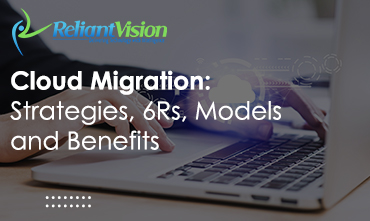Cloud migration strategy refers to the plan and approaches that an organization follows when moving its data, applications, and computing resources from on-premises or other cloud environments to a cloud computing platform. Developing a well-defined cloud migration strategy is crucial to ensure a smooth and successful migration process.
Here are some key steps that organizations can consider when developing a cloud migration strategy:
- Define the objectives and goals: Clearly define the reasons and expected outcomes for migrating to the cloud. This could include improving scalability, reducing costs, enhancing agility, or accessing new features and capabilities.
- Choose the right cloud provider and services: Select a cloud provider that aligns with the organization’s requirements and objectives. Consider factors such as pricing, performance, reliability, security, and compliance. Choose the appropriate cloud services, such as Infrastructure as a Service (IaaS), Platform as a Service (PaaS), or Software as a Service (SaaS), based on the organization’s needs.
- Develop a migration plan: Create a detailed plan that outlines the steps, timeline, and resources required for the migration. Define roles and responsibilities, establish communication channels, and set milestones to track progress.
- Assess potential risks: Identify potential risks and challenges associated with the migration, such as data loss, downtime, or performance issues.
- Prepare for data migration: Develop a plan to transfer data to the cloud, including data mapping, validation, and migration methods. Consider data transfer costs, data integrity, and data privacy requirements.
- Test and validate: Conduct comprehensive testing and validation of applications and workloads in the cloud environment to ensure they are functioning as expected.
- Train and educate users: Provide training and education to users who will be using the cloud-based applications and services. Familiarize them with the new environment, its features, and any changes in workflows or processes.
- Monitor and optimize: Establish monitoring and performance optimization mechanisms to continuously monitor the cloud environment and optimize resources for cost, performance, and security.
- Post-migration review: Conduct a post-migration review to assess the success of the migration and identify areas for improvement.
The 6Rs of cloud migration strategy are a framework that organizations use to determine the most appropriate approach for migrating their applications to the cloud. The 6Rs stand for:
- Rehost: In this approach, applications or workloads are moved from on-premises or another cloud environment to the cloud with little or no modification
- Replatform: In this approach, applications or workloads are moved to the cloud with some modifications to optimize them for the cloud environment.
- Repurchase: In this approach, organizations replace their existing applications with cloud-based, off-the-shelf software-as-a-service (SaaS) solutions.
- Refactor: In this approach, organizations make significant changes to the application architecture or design to modernize or optimize it for the cloud.
- Retain: In this approach, organizations decide to keep certain applications or workloads on-premises or in a private cloud environment, rather than migrating them to a public cloud.
- Retire: In this approach, organizations identify and retire applications or workloads that are no longer needed or have become obsolete.
The choice of cloud deployment model depends on the specific requirements, and goals of an organization. Here are some common cloud deployment models to consider:
- Public Cloud: This deployment model involves using cloud resources and services provided by a third-party cloud services provider, such as Amazon Web Services (AWS), Microsoft Azure, or Google Cloud Platform (GCP).
- Private Cloud: In this model, cloud resources and services are dedicated to a single organization and not shared with other customers.
- Hybrid Cloud: This model involves a combination of both public and private clouds, allowing organizations to leverage the benefits of both.
- Community Cloud: This model involves sharing cloud resources and services among a group of organizations with similar interests, such as those in the same industry or with common regulatory requirements.
Conclusion:
We at Reliant Vision offers numerous benefits to organizations for cloud migrating, which are:
- Cost Savings: Reliant Vision allows organizations to shift from upfront capital expenses to a pay-as-you-go operational expense model, where they only pay for the resources and services they use.
- Scalability and Flexibility: We provide the ability to easily scale up or down resources based on demand, allowing organizations to quickly respond to changing business needs.
- Agility and Innovation: We provide a platform for rapid application development and deployment, enabling organizations to quickly experiment, innovate, and bring new products or services to market.
- Global Reach: We at Reliant Vision allow organizations to access and deploy applications and services globally, without the need for extensive physical infrastructure in different locations.
- Enhanced Security and Compliance: We also provide robust security measures, including data encryption, access controls, and monitoring, to protect data and applications.

